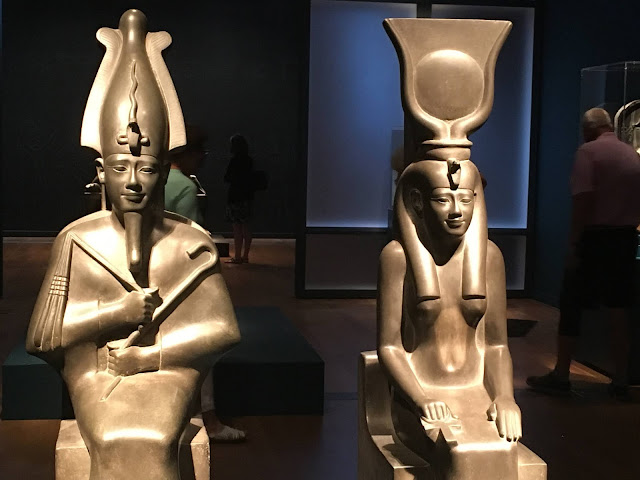Osiris was born the eldest child of Feb (Earth) and Nut (Sky). Destined to be a king, he brought peace to the ancient Egyptians and introduced agriculture to the land, ensuring its fertility with the annual flood of the Nile River. In art, Osiris often holds a shepherd's crook and a grain-threshing flail crossed over his chest.
Seth was Osiris's jealous brother, who murdered Osiris and scattered pieces of his body throughout the land. So began the bitter contest between Seth and the forces of Osiris. Isis, Osiris's devoted sister and wife, searched for the pieces of her husband after the fight between the brothers. She reassembled Osiris's body and created the first mummy. With the help of their sister Nephthys, Isis brought Osiris back to life. Reunited with her husband, Isis became pregnant with Horus-the-Child, called Harpokrates by the Greeks.
Horus-the-Child was secretly raised in the papyrus marshes, hidden from Seth along the banks of the Nile River. Often portrayed with the head of a falcon, Horus grew up to be the heir of Osiris. After losing one eye while battling Seth, Horus vanquished his father's murderer. Restoring order to the world, Horus reunited the two kingdoms of Egypt and took his rightful pace as pharaoh. Osiris became the god of the endless cycle of death, resurrection and fertility.
The Mysteries of Osiris was celebrated in the month of Khoiak after the waters of the Nile flood receded. In the ceremonies, images of Osiris were created to ensure the fertility and prosperity of Egypt.
Statues of Osiris and Isis, c. 570 - 526 BC
The depiction of Osiris on the left was found together with the statue on the right of Isis, his sister-wife. Osiris was a god of rebirth and ruler of the land of the dead, which Egyptians loaded in the west, the direction of the setting sun. Here, the inscription reads: 'Osiris, who resides in the west, great god, lord of Ro-Setaou.'
Temple Slab from ca. 664 - 332 BC, depicting Osiris standing in the doorway flanked by Isis on the left, his wife and sister, and Nephthys (right), their sister. After their brother Seth murdered Osiris, the two sisters protected and mourned over the god's body while conspiring to revive him. At funeral ceremonies and during festivals honoring Osiris, the lamentations of Isis and Nephthys were recited and reenacted in Egyptian temples.
Statue of Tawaret, 664 - 610 BC
Tawaret, 'the Great One,' protected new mothers and infants, warding off evil with her fearsome appearance. Here, the goddess is shown with the head and body of a hippopotamus, the limbs of a lion, and the tail of a crocodile. In the Osiris myth, Tawaret guards Isis and the newly born Horus against Seth.
Slab of Horus, 380 - 280 BC This object was used for healing rituals: water poured over the slab absorbed the power of the image and magical inscriptions as it flowed into a basin. Worshippers collected the water for its healing powers.
The upper part of the slab depicts Horus, the son of Osiris and Isis, with an amulet and the thick side-lock of hair worn by Egyptian children. He stands naked, drawing power from the fierce and dangerous animals he has subdued: the crocodiles upon which he stands and the animals he grasps in his hands - arched scorpions, snakes, a chained oryx with sharpened horns (right) and a lion (left).
This statue portrays Osiris newly awakened after death. Covered in a thin garment, he lifts his head and smiles. Osiris's beard is a symbol of his divine kingship and his crown, with its sun disk, ostrich feathers, and twisted rams' horn, a symbol of rebirth.





No comments:
Post a Comment